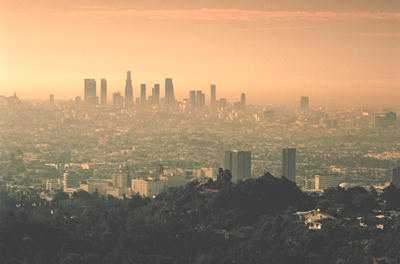
...................................................................................................................................................
Ozone Pollution
BY CRAIG FREUDENRICH, PH.D.
The weather
report on the radio or TV tells you
that it is going to be sunny and hot and that an orange ozone alert has
been issued.
What is ozone?
What does an orange alert mean? Why should you be concerned about it?
In this article, we will examine what ozone is, how it is produced, what health hazards it poses and what you can do to reduce ozone pollution.
In this article, we will examine what ozone is, how it is produced, what health hazards it poses and what you can do to reduce ozone pollution.
Ozone is
a molecule of three oxygen atoms bound together (O3).
It is unstable
and highly reactive.
Ozone is used
as a bleach, a deodorizing agent, and a sterilization agent for air and
drinking water. At low concentrations, it is toxic
Ozone can also
be found in the troposphere, the lowest layer of the
atmosphere.
Tropospheric
ozone (often termed "bad" ozone) is man-made, a result
of air pollution from internal
combustion engines and power plants.
Automobile
exhaust and industrial emissions release a family of nitrogen oxide
gases (NOx) and volatile organic compounds (VOC), by-products
of burning gasoline and coal.
NOx and VOC
combine chemically with oxygen to form ozone during sunny, high-temperature
conditions of late spring, summer and early fall.
High levels of
ozone are usually formed in the heat of the afternoon and early evening,
dissipating during the cooler nights.
Although ozone
pollution is formed mainly in urban and suburban areas, it ends up in rural
areas as well, carried by prevailing winds or resulting from cars and trucks
that travel into rural areas. Significant levels of ozone pollution can be
detected in rural areas as far as 250 miles (402 kilometers) downwind from
urban industrial zones.
Avoiding and Reducing Ozone
When you inhale
ozone, it travels throughout your respiratory tract.
Because ozone
is very corrosive, it damages the bronchioles and alveoli in your lungs, air sacs that
are important for gas exchange.
Repeated
exposure to ozone can inflame lung tissues and cause respiratory infections.
Ozone exposure
can aggravate existing respiratory conditions such as asthma, reduce your lung
function and capacity for exercise and cause chest pains and coughing.
Young children,
adults who are active outdoors and people with respiratory diseases are most
susceptible to the high levels of ozone encountered during the summer.
In addition to
effects on humans, the corrosive nature of ozone can damage plants and trees.
High levels of ozone can destroy agricultural crops and forest vegetation.
Avoiding Ozone
Exposure
To protect yourself from ozone exposure, you should be aware of the Air Quality Index (AQI) in your area everyday -- you can usually find it in the newspaper or on a morning weather forecast on TV or radio.
To protect yourself from ozone exposure, you should be aware of the Air Quality Index (AQI) in your area everyday -- you can usually find it in the newspaper or on a morning weather forecast on TV or radio.
You should also
be familiar with the U.S. Environmental Protection Agency (EPA)
guide for ozone-alert values.
What do the
numbers in the AQI mean?
The AQI
measures concentrations of five air pollutants: ozone, sulfur dioxide,
particulate matter, carbon monoxide and nitrogen dioxide.
The EPA has
chosen these pollutants as criteria pollutants, but these are not all of the
pollutants in the air.
These
concentrations are compared to a standard set out in federal law.
An index value
of 100 means that all of the criteria pollutants are at the maximum level that
is considered safe for the majority of the population -- a yellow alert on the
chart below.
Numbers above
100 indicate higher concentrations and therefore a greater risk to most
individuals.
U.S. EPA Air
Quality Guide for Ozone
|
|||
Air
Quality Index
|
Color
|
Air
Quality
|
Prediction
|
0 to 50
|
Green
|
Good
|
No health impacts
are expected.
|
51 to 100
|
Yellow
|
Moderate
|
Unusually sensitive
people should limit prolonged outdoor activity.
|
101 to 150
|
Orange
|
Unhealthy for
sensitive groups
|
Active people and
those with respiratory disease should limit prolonged outdoor activity.
|
151 to 200
|
Red
|
Unhealthy
|
Active people and
those with respiratory disease should avoid prolonged outdoor activity; all
others should limit prolonged outdoor activity.
|
201 to 300
|
Purple
|
Very unhealthy
|
Active people and
those with respiratory disease should avoid all outdoor activity; all others
should limit outdoor activity.
|
To reduce your
exposure to ozone, you should avoid exercising during afternoon and early
evening hours in the summer.
Reducing Ozone
Pollution
There are several ways you can help to decrease ozone pollution:
There are several ways you can help to decrease ozone pollution:
· Limit using your automobile during afternoon and early evening
hours in the late spring, summer and early fall.
· Do not use gasoline-powered lawn equipment during these times.
· Do not fuel your car during these times.
· Do not light fires or outdoor grills during
these times.
· Keep the engine of your car or boat tuned.
· Make sure that your tires are
properly inflated.
· Use environmentally safe paints, cleaning and office products
(some of these chemicals are sources of VOC).
· Conserve energy.
Besides
personal attempts to reduce ozone pollution, the EPA has initiated more
stringent air-quality standards (such as the Clean Air Act and its
modifications) to reduce air pollution.
Compliance with
these standards by industries, manufacturers and state and local governments
has significantly reduced the levels of many common air pollutants.
With continued
conservation and reduction practices, adherence to ozone-pollution warnings,
research and government regulation, ozone-pollution levels should continue to
fall.
Perhaps future
generations will not be threatened by this environmental pollutant.
Make Your Own Ozone
Detector
You can make ozone
test strips to detect and monitor ozone levels in your own backyard or around
your school. You will need:
· corn
starch
· filter
paper (coffee filters work well)
· potassium
iodide (can be ordered from a science education supplier such as Carolina Biological Supply or Fisher
Scientific)
Basically, you make a paste from water, corn starch
and potassium-iodide, and you paint this paste on strips of filter paper.
You then expose the strips to the air for eight
hours. Ozone in the air will react with the potassium iodide to change the
color of the strip.
You can then read the
ozone concentration from a chart that is available at this
Web site.
You will also need to know the relative
humidity,
which you can get from a newspaper, weather broadcast or home weather station.
See Ground
Level Ozone Testing for
details.
Craig Freudenrich, Ph.D., is a freelance science writer. He earned a
B.A. in biology from West Virginia University and a Ph.D. in physiology from
the University of Pittsburgh School of Medicine. He has over 25 years
experience in biomedical research, science education, and science writing.
 |
OZONE IS A MAJOR COMPONENT OF SMOG
|
 |
Ozone production from NOx pollutants: Oxygen atoms freed from nitrogen dioxide by the action of sunlight attack oxygen molecules to make ozone. Nitrogen oxide can combine with ozone to reform nitrogen dioxide, and the cycle repeats
|
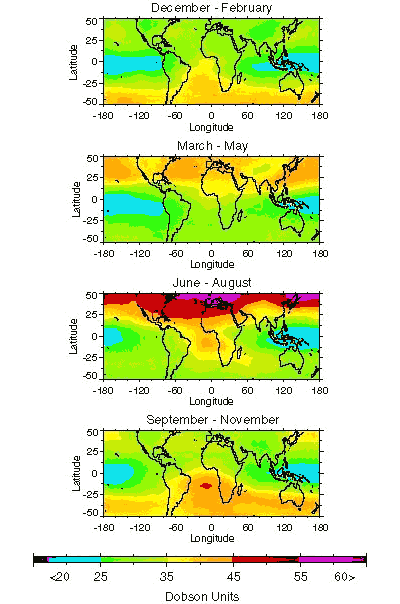 |
Worldwide seasonal changes in tropospheric ozone: Tropospheric ozone increases during summers in the northern and southern hemispheres when the climate is hot. The most tropospheric ozone is observed during summer in the northern hemisphere.
|
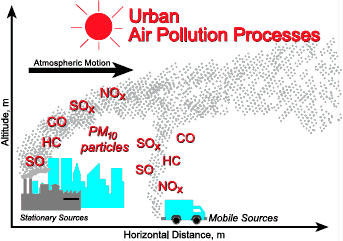 |
Ozone pollution can travel from urban to rural areas.
|

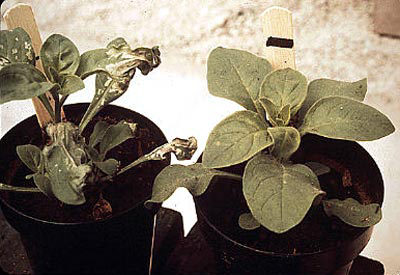 |
Ozone-damaged plant (left) and normal plant (right)
|
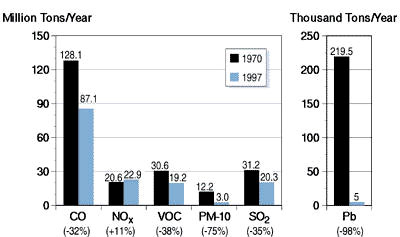 |
Changes in air-pollution emissions in the United States
|
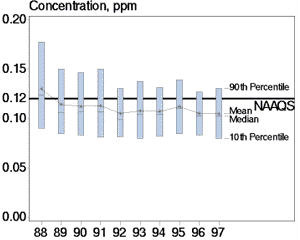 |
Changes in ozone concentration in the United States (black line represents air-quality standard)
|

No comments:
Post a Comment